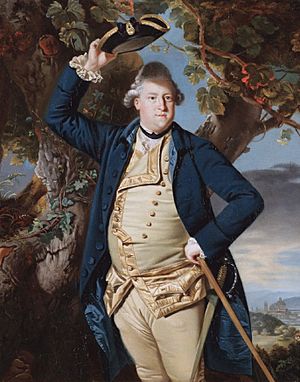George Clavering-Cowper, 3rd Earl Cowper facts for kids
Quick facts for kids
The Earl Cowper
|
|
|---|---|

The Earl Cowper by Zoffany.
|
|
| Member of Parliament for Hertford |
|
| In office 1759–1761 |
|
| Preceded by | George Harrison |
| Succeeded by |
|
| Personal details | |
| Born | 1738 |
| Died | 22 December 1789 (aged 51) |
| Resting place | Hertford, England |
| Nationality | English |
| Spouse | Hannah Clavering-Cowper née Gore |
| Relations |
|
| Children |
|
| Residence | Villa Palmieri |
George Nassau Clavering-Cowper, 3rd Earl Cowper (born 1738 – died 22 December 1789) was an English nobleman. He inherited his title and lands. As a young man, he took a special trip called the Grand Tour. But instead of returning home, he moved to Italy.
Even though he became a member of the British Parliament, he stayed in Italy. There, he collected many valuable artworks. He also became a Prince in the Holy Roman Empire. He was known for supporting artists and scientists.
Contents
Life Story of Earl Cowper
George Nassau Clavering-Cowper was the son of the 2nd Earl Cowper. He was also the godson of King George II. George went to Eton College for his education.
His family planned for him to finish his studies with a "Grand Tour." This was a common journey for young British noblemen. They would travel across Europe with a teacher.
The Grand Tour
At this time, Clavering-Cowper was known as Viscount Fordwich. He traveled through France, the Netherlands, and Germany. Then, he studied for two years in Switzerland. Unlike many other young travelers, Fordwich was financially independent. He had inherited a lot of money from his grandfather in 1754.
On July 7, 1759, Fordwich and his teacher arrived in Florence, Italy. His father expected him to return to England. His father even arranged for him to be elected as a Member of Parliament for Hertford in December 1759.
However, Fordwich was enjoying life in Florence. He was becoming a part of Florentine society. By the next year, his teacher, Jean Chastellain, asked to leave. Fordwich's father allowed the teacher to return home.
Life in Florence
On June 2, 1775, George married Hannah Anne Gore. She was sixteen years old. Her father, Charles Gore, asked the artist Zoffany to paint a picture to celebrate their engagement.
In 1780, George bought the Villa Palmieri in Fiesole. This beautiful house overlooked the city of Florence. George and Hannah had three children. Their first two sons later became the 4th and 5th Earl Cowper.
Even though George lived far from his family in England, he still had important connections. He wanted to become the official British representative in Florence. He tried to gain favor with the King of England. He sent paintings and copies of Italian artworks to the King.
The job he wanted was held by Sir Horace Mann. Mann was the official British diplomat in Florence. Even though Mann was well-liked, Cowper found other ways to be successful. He helped to build a monument for Machiavelli's tomb. This monument was placed in the Church of Santa Croce.
Cowper also managed to become a Prince of the Holy Roman Empire. His title was Prince of Nassau d'Auverquerque. He received permission from King George III to use this title. His mother's family name was "Nassau d'Auverquerque."
Cowper only returned to England once. It was a very short visit after more than thirty years away. His return was so unusual that Horace Walpole wrote about it. In a letter, Walpole said he was surprised to see
an English Earl who was more proud of a small principality and a minor award from Württemberg than being a British peer.
Earl Cowper's Art Collection
Collecting art took up a lot of Cowper's time and money. He owned many famous paintings. Two of his most important pieces were by the artist Raphael. These are known as the Small Cowper Madonna and the Niccolini-Cowper Madonna.
The Niccolini-Cowper Madonna is special because Cowper himself is shown with it in another painting. The painting Tribuna of the Uffizi shows Cowper looking at the painting. The artist Johann Zoffany is offering it to him. Zoffany had bought the painting in 1782 and sold it to Cowper in 1785.
Zoffany was in Italy to paint the Tribuna for the British royal family. However, Zoffany lost his job as a court painter. This was because he included other people in his painting. Cowper was considered acceptable, but the other figures were not.
Cowper used Zoffany's skills to make his art collection even better. He also gave Zoffany other jobs. Zoffany painted Cowper and his fiancée separately. He also included them both in the painting for Cowper's father-in-law.
Cowper collected works by many artists. These included Giuseppe Antonio Fabrini, Francesco Zuccarelli, Jakob Philipp Hackert, and Hugh Primrose Dean. After 1778, Cowper bought Holy Family by Fra Bartolommeo. He also supported artists like Joseph Plura, Innocenzo Spinazzi, Hugh Douglas Hamilton, and Jacob More.
Supporting Others
Cowper did not just support artists. He also helped his cousin, William Cowper, who was a famous poet. George gave him money every year.
Count Volta, a scientist, also received help from Cowper. Cowper gave Volta a complete laboratory. They also wrote letters to each other. Cowper helped Volta translate a paper for the Royal Society.
Death and Legacy
Earl Cowper passed away on December 22, 1789, at 51 years old. He died from an illness. His body was brought back to England and buried in Hertford.
His oldest son, George Augustus, inherited his title. His second son, Peter Leopold Louis Francis Nassau, became the 5th Earl in 1799. He held the title for 38 years. This meant Cowper's youngest son, Edward Spencer, never became Earl.
Images for kids




